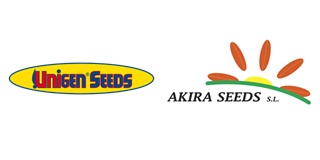
UNIGEN SEEDS SPAIN
MA packaging for cherries better maintained the fruit quality than the carry bags during a storage period of 8 days at two simulated retail conditions
The shelf life of fresh sweet cherries (Prunus avium L.) is limited due to factors such as fungal fruit decay, stem browning, weight loss and tissue softening. Packaging in modified atmosphere (MAP) may inhibit these changes and prolong shelf life. The aim of this experiment was to evaluate the effect of two types of packages on weight loss and decay for sweet cherries under realistic retail conditions. Sweet cherries ?Lapins? of two maturity grades were packaged in open polyethylene pouches (?carry bags? - control) as used by the Norwegian packing houses today, and in trays packaged in a laser perforated film on a flowpack machine giving modified atmosphere (MAP). After packaging, the cherries were stored at 4?C for 5 days and thereafter at 4?C or 20?C for 3 days simulating storage
27 September, 2017
The shelf life of fresh sweet cherries (Prunus avium L.) is limited due to factors such as fungal fruit decay, stem browning, weight loss and tissue softening. Packaging in modified atmosphere (MAP) may inhibit these changes and prolong shelf life. The aim of this experiment was to evaluate the effect of two types of packages on weight loss and decay for sweet cherries under realistic retail conditions. Sweet cherries ?Lapins? of two maturity grades were packaged in open polyethylene pouches (?carry bags? - control) as used by the Norwegian packing houses today, and in trays packaged in a laser perforated film on a flowpack machine giving modified atmosphere (MAP). After packaging, the cherries were stored at 4?C for 5 days and thereafter at 4?C or 20?C for 3 days simulating storage at chill or room temperature in the retail stores. Gas atmosphere in the perforated packages, fruit quality, weight loss and amount of fungal fruit decay and other decays were recorded after 1 and 5 days and at the end of the storage period. The gas atmosphere in MA packages was approximately 18% O2 and 4% CO2 at 4?C and between 6-9% O2 and 12-14% CO2 at 20?C. The weight loss was negligible in the MA packages at both storage conditions, whereas the cherries in carry bags showed a weight loss of 1.1% after 5 days at 4?C, increasing to 2% after further 3 days at 4?C and 4% at 20?C, respectively. Stem colour was evaluated at the end of storage period. The stems was significantly browner in the carry bags compared to the MA packages. Values for firmness and colour as measured by texture analyser and Minolta (L, a* and b*), respectively, showed that cherries in MA packages had slightly higher values than the cherries in carry bags, but this difference was not significant at 5% level. Below 0.5% fungal decay was detected after 8 days at 4?C for both maturity grades, whereas 4% decay was detected in MA-packages and 6% decay in carry bags for the less mature cherries stored for 5 days at 4?C and thereafter 3 days at 20?C. The most mature cherries stored at 4?C and thereafter 3 days at 20?C had 9% decay in the MA-packages and 7% decay in the carry bags. The overall picture was that MA packaging for cherries better maintained the fruit quality than the carry bags during the storage period of 8 days at two simulated retail conditions. SourcesMA-packages in simulated retail conditions improves sweet cherry fruit qualityHanne Larsen1, Jorunn Borve21P.O. Box 210 NO-1431 Norway, 1430 Aas, Norway2Norwegian Institute of Bioeconomy Research (NIBIO) Ullensvang, 5781 Lofthus, NorwayVIII International Postharvest Symposium?Cartagena, 21-24 June 2016Picture, by Dave Wilson Nursery, http://www.davewilson.com/product-information/product/lapins-cherry









